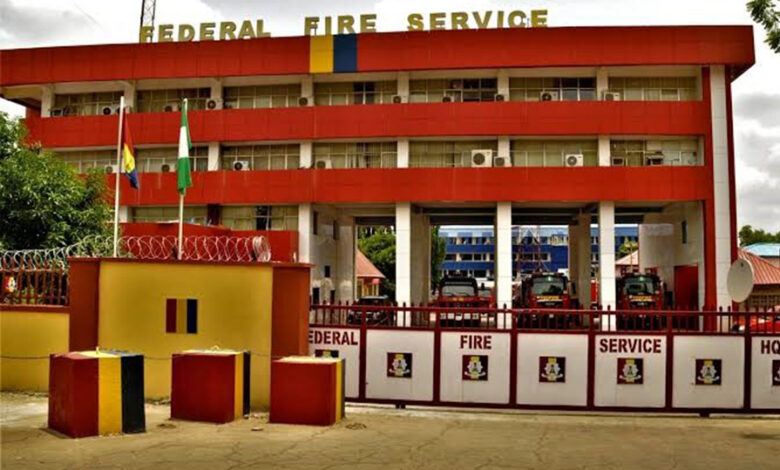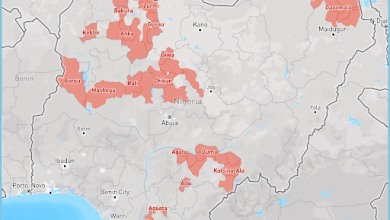Recurring Market Fires Expose Loopholes In Nigeria’s Emergency Response Time
In 2021, marketplaces in the Federal Capital Territory witnessed one too many fire outbreaks; beyond the disturbing frequencies at which the fire incidents were recorded, a seeming laxity in the emergency response-attitude of the Federal Fire Service, was brought to the fore

Perennial fire outbreaks are not new to Nigerians. At least twice a year, major incidents are reported across the country and in most cases, the affected structures are markets.
The Balogun market, a popular trading centre located in Lagos State, Southwest Nigeria, has recorded fire outbreaks every year since 2015. In Dec. 2021, about three shops were razed by fire at the market. In Dec. 2019, a fire outbreak was recorded at the market after a previous one a month before. In Feb. 2018, a fire reportedly started around 11 a.m. local time and razed six flats at the Balogun market. In 2017, a similar case was reported. In Sept. 2015, about three persons were reported dead, and some others injured, after they jumped from various floors of the affected building to escape.
The Balogun market fire incidents may have been recorded in far away Lagos State, but the situation in Abuja, Nigeria’s capital city is not so different.
The fire incidents in Abuja markets are equally recurrent and after each fire outbreak, there is a trader who has to labour from scratch, to rebuild all that the fire has destroyed. For instance, Francis Azi, a trader at Kugbo furniture market, has had to start life from scratch, not once, but twice, after recurring fires razed his furniture shops.
In 2013, Azi lost millions of naira and even a customer to the fire. The most recent fire which gutted the market in Jan. 2021, had come just a few weeks after he purchased an edging machine which cost him about N8.5 million. Azi also lost four extra edging machines worth N4.5 million, a wood sawdust dryer and some machines worth about six to seven million naira.
In addition, he lost four of his shops which housed Mikano generators, working equipment, finished furniture and industrial machines for production, all of which are worth millions of naira.
Azi was not the only one.
The Nation newspaper reported that over 80 timber sheds, 300 furniture shops, and numerous valuables were consumed by the infamous Kugbo market fire of 2021.
Before the Jan. 2021 fire, though, the Kugbo market recorded a similar incident in 2013, in 2020 and even thrice before that.
In 2021, the media was agog with reports of fire incidents in Abuja. This started as early as January with the Kugbo furniture market as the first place to go down in ashes.
Traders at the location suffered losses running into millions of naira after more than 80 shops belonging to timber traders were razed to the ground by an inferno.
Six months later, on July 6, a late night fire broke out at the Karimo market, consuming about 200 shops. The figure given by the fire service was disputed by an eyewitness who put the number of destroyed shops at 309 and also alleged that the fire service did not arrive at the scene on time.
A few weeks after the inferno at Karimo market, another fire broke out at the popular Ebeano supermarket on July 27, destroying goods worth millions of naira.
In November, another fire erupted at the Kubwa village market, claiming the lives of 10 persons including a pregnant woman, and injuring several others.
Some three weeks later, still in the month of November, a popular market at Nyanya equally went up in flames, leading to the destruction of numerous valuables.
Then, just as the year was coming to an end, the popular Next Cash and Carry supermarket went up in flames a day after Christmas, burning down goods worth millions of naira.
Beyond the disturbing frequency at which the fire outbreaks occurred, one thing was brought to the fore; the attitude of the fire service towards such emergencies.
Allegations of poor response time
According to ScienseDirect, a source for scientific, technical and medical research, the ideal emergency response time is five minutes. What this means is that the Federal Fire Service (FFS) is supposed to provide aid within that time frame. The level of damage resulting from the aforementioned destruction suggests that the service may not have abided by the time stipulation.
Aggrieved victims, such as Azi who lost millions to the Kugbo market fire, have alleged that the fire service did not arrive at the scene of the incident on time.
In a report published by Vanguard, a trader at the Karimo market alleged that the fire service arrived at the scene of the incident late. Similar cases were reported (and disputed by some) at the Kubwa, Ebeano, Nyanya, and Karimo fires.
But Braimoh Momoh, assistant controller-general of the FFS in the FCT, said that the reason behind the late responses was not laxity on their part, but rather, the failure of eye witnesses to report on time.
Momoh, who made the statement in a television programme, also commented on the Next Cash and Carry fire outbreak, saying that they (fire service) responded promptly to that incident.
“…we activated all relevant agencies. The national security adviser activated all relevant agencies. All over, there was communication and synergy that everybody had to be there and which we actually did, but the issue was that it was reported late,” he said.
Contrary to the submission made by Momoh, the owner of a fast food restaurant at the Next Cash and Carry mall, said that she lost everything in her restaurant and that “the situation would have been different had officials of the federal fire service and National Emergency Management Authority (NEMA) arrived on time to put out the fire and save valuable items.
“Firefighters only showed up when the entire building had been reduced to ashes. This type of thing cannot happen in a country where things work normally,” she said.
Another business owner shared similar sentiments: “I am in pain. With rapid response, I may have at least salvaged something,” he said.
“We called the fire service and NEMA but none of them showed up until the damage had been done,” he continued.
Austin Daniel, a shop owner close to the mall added that “those firefighters came about one hour after they were called and some of their trucks that first got here did not have water. It was here that they started looking for fire hydrants to fill their tanks.”
Does the FCT have sufficient fire service stations?
An official of the federal fire service who did not want to be named told HumAngle that sometimes, they indeed arrive at the scene of fire incidents late but “this is not completely our fault.”
The official cited lack of adequate fire service stations as the cause of the slow response time, explaining that “sometimes our men can go on a fire fighting mission and they will get stuck in traffic and when they get to the scene of the incident, the people there would begin to fight them. If there were sufficient fire stations in strategic places, this would not be so, because then, the proximity to those places in distress would not be so much,” the official concluded.
According to the FCT Emergency Management Agency (FEMA), the fire stations in the territory include the FCT Fire Service (Asokoro), FCT Fire Service (Gwarimpa) and FCT Fire Service Headquarter (Garki), and then one Fire Brigade station (Wuse 1).
Other fire stations, according to google listings include Apo fire service station, the FCDA fire service located in Utako, the fire station located in Zuba, the fire service station located in Sauka, and the National Emergency Management (NEMA) outpost in Wuse 2, Garki.
There are about nine fire stations, at least, within the general Abuja area that has a landmass of 7,315km2.
What GIS says
A Geographic Information System (GIS) search done by HumAngle revealed that four of the main fire stations are compactly located within a 12-kilometre radius of each other at the heart of the FCT.
What this means is that all four fire stations are within five minutes of places within the Abuja Municipal Area Council (AMAC) of the FCT which is one of six other area councils making up the national capital city and is also where the most concentration of government, administrative, business and commercial buildings are situated.
This dense concentration of the fire service, from all indications, constitutes a hindrance to the ability of the stations to promptly respond to incidents across the FCT. In the same vein, it makes every other location in the territory more prone to suffer damage from fires as they are not only more than five minutes away from the nearest response time, but some are hours away and out of reach within reasonable travel distance of any of the fire service stations.
For instance, the 2021 Prince Ebeano supermarket fire was out of reach of most of these stations’ fastest response time, except for the Apo fire station which is situated about 10 minutes away from the scene. Ironically, the firefighters from the far off fire stations in Asokoro, Garki, Games Village, and the National Judicial Institute in Abuja were reportedly the ones on the scene during the incident, exposing the poor geographic arrangement of these stations in the FCT and likely contributing to the exacerbation of the fire.
That notwithstanding, proximity analysis estimates show that some places within this adequate distance were also not spared from the full extent of fire damage in recent times. Such cases include the Next Cash and Carry shopping mall and Kugbo furniture market which were both gutted by fire in 2021.

The budget of the Federal Fire Service over the past four years shows that they have expended N337.2 million to purchase motor vehicles and N302.3 billion for fire-fighting equipment from 2016 to 2020. It is not clear, the mode, pattern, and criteria for the distribution of the fire-fighting equipment and whether they are being put to use at all.
HumAngle tried to reach the spokesperson of the FFS to find out the number of operational vehicles to no avail.
Satellite images, however, show the vehicles available within the premises of the FCT fire stations. While it may be difficult to exactly tell how many vehicles there are in the stations and how functional they are, multiple images of the areas show changes in the parking positions of the service vehicles, indicating that they may be operational.

The satellite images of the Fire Brigade compound show an average of five vehicles on site. The images also show that there has been a change in their position over the course of two years (2020 and 2021).
Again, the images show a similar composition of vehicular activities in the FCT Fire Service (Asokoro) compound which has an average of three in the premises between 2020 and 2021
From the GIS findings of HumAngle, the total number of fire stations and vehicles in the Federal Capital Territory (FCT) cannot be said to be adequate for a city with a landmass of 7,315km2 and a population that seems to grow by the day.
Responsibilities of the fire service
According to the fire service Act of 1963, the FFS is charged with the responsibility of extinguishing, controlling, and preventing fires. Also, the protection of lives and properties in addition to any other humanitarian endeavours as may be required of them.
They are also required to provide fire hydrants and other sources of water supplies and marks indicating the location of such hydrants or sources of water. While their ability to fulfil these obligations have been put into question severally by the public, the fire service has always maintained that they have appropriately discharged their duties.
One of their duties, which they seem to derail in, is the provision of fire hydrants at various points. Of the 63 persons who participated in a Twitter poll conducted by HumAngle, only 23 per cent have seen a fire hydrant in their neighbourhood while 76.2 percent said that they have never seen one.
Every year, business owners incur losses running into millions of Naira, due to the seemingly poor attitude of the Federal Fire Service to fire incidents, and there seems to be no end in sight, as authorities who are supposed to fight these fires often trade blames with affected business owners and bystanders.
One way in which both parties can help the situation is by dialling the 112 Nigerian emergency number, and in the case of the fire service, swift response to emergencies as well as the execution of other functions as stated in the fire service Act.
Support Our Journalism
There are millions of ordinary people affected by conflict in Africa whose stories are missing in the mainstream media. HumAngle is determined to tell those challenging and under-reported stories, hoping that the people impacted by these conflicts will find the safety and security they deserve.
To ensure that we continue to provide public service coverage, we have a small favour to ask you. We want you to be part of our journalistic endeavour by contributing a token to us.
Your donation will further promote a robust, free, and independent media.
Donate HereStay Closer To The Stories That Matter




